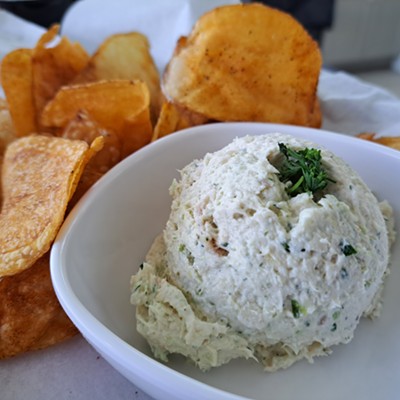For the over 1800 inmates in the Chatham County Detention Center, breakfast has been served. ABL Management, based in Baton Rouge, La., serves inmate meals on a precise schedule:
Breakfast between 5-7 a.m. Lunch starts at 10 and is complete no later than 11:45. Dinner tray-up starts at 4 p.m. and the population is fed by 6 p.m. Period.
If for one of a variety if reasons — court, visitation, medical, arrival time — you don’t get the main meal, you get fruit, a drink and two sandwiches.
Menus run on four-week cycles. Joe Maloney, ABL’s onsite manager and Col. Holmes, the Correction Center’s chief administrator, both confirm: the chicken is an inmate favorite. But we’re there for lunch, and chicken’s on the dinner menu.
In any case, here is the complete three-meal diet served to each inmate (that’s not on a special diet) on February 14, 2008:
Breakfast: ½ cup of orange juice, 1 cup of grits with margarine, 4 ounces of scrambled eggs, 1 ounce of turkey sausage (1 patty), 1 piece of white cake, 8 ounces of black coffee, 2 sugar packets.
Lunch: BBQ Turkey Sloppy Joes, ½ cup of home fries, 2 packets of ketchup, ½ cup of cole slaw, ½ cup of vanilla pudding, 6 ounces punch with vitamin C,
Dinner: 1 breaded 3 ounce Beef Patty (baked),¼ cup grilled onions, ½ cup mashed potatoes, ¼ cup gravy, ½ cup of vegetables, 2 slices of bread, margarine, glazed cake, 6 ounces of sweetened tea.
All of this for a unit cost to Chatham County of approximately 70 cents a meal. The total food service budget for the fiscal year is $1,530,0000. Over 2,000,000 detainee meals a year will be served.
The Detention Center provides kitchen equipment, utilities and inmate labor. Inmate labor is paid out of profits generated through the Detention Center commissary.
I ate the detainee lunch of the day: same food, same portion size. The hot food is hot, the cold food cold. The coleslaw is freshly made; the Sloppy Joe mix is cooked in steaming cauldrons.
At first bite they’re bland. Maloney explains: “We have to be careful about spices. A lot of people are on low salt diets for hypertension.”
I add salt and pepper and the coleslaw and Sloppy Joe jump to life. But there isn’t even enough Sloppy Joe for a sandwich so I use my bun to absorb the sauce and my only utensil- a disposable spoon - to eat the meat, slaw and pudding.
American Corrections Association mandates a minimum daily caloric value of 2700 calories for adult detainees. ABL’s menus either meet or exceed that.
I ask Maloney about ground turkey, hoping it’s used because the L-tryptophan in turkey causes drowsiness -- what a cool way to control inmate behavior! But I’m disappointed. His too-simple answer? “It’s more nutrious then ground beef.”
Somehow I miss french fry preparation. Maybe because I’m surrounded by tan uniformed “kitchen trustees”: detainees preparing the food and traying the meals.
No, not surrounded, just doing their jobs: But I know they’re there and that for some of them there’s a legitimate reason why. I’m not scared or nervous: but I’m glad the kitchen’s only two knives are securely locked and cabled to table legs.
There are always at least two long-term ABL employees per shift. But the nature of this detainee labor pool is transient.
Kitchen trustees are part of two 18-man crews. Joe explains: “They are low-level felons, misdemeanors, they could be released the same day they arrive. We deal with it. We do lots of cross training. We also have some that have comeback after they’ve been re-arrested and they get assigned to the kitchen.”
Trustees work one day on, one day off. Three days one week, four days the next. They come in at 4 a.m. to prepare breakfast. They get a break in the afternoon, then they’re brought back to do dinner.
Kitchen Trustees are paid $2 a day and they get double meal portions on the days that they work.
Most of the Center’s inmates are pre-trial detainees. Sixty to seventy percent are repeat offenders. Less than 10 percent have been sentenced to do their time there.
Sgt. Tillman explains: “If they’re doing less then 12 months on a misdemeanor they can be sentenced to do their time here. They will have finished their time before a bed space opens up in the state system.”
When we first arrive Maloney takes me to the bakery area. A trustee multi-tasks: He’s organized, diligent, confident and proud of the good work he is doing. That’s so rare in kitchen employees that I want to hug him, but think better of it.
At $2 a day for labor it makes sense to bake, not buy. I eat a chocolate cookie, it’s got a great chewie texture and it’s delicious. The bakery also produces cake and biscuits of course, and being that we are in the South, cornbread. And it smells terrific.
We get a quick tour of the jail from Sgt. Tillman. It’s not like the movies or television. The hot and sexy women behind bars? There are 228 female detainees on Valentines Day, when I visit.
We watch as inmates get their meds: morbid curiosity forces me to watch, but outside of smokers it’s the most un-sexy thing I’ve ever seen. The behemoths that lift weights all day? There are no weights here; weights would be used as weapons.
Back in the kitchen the precision trustee service line is cranking out meals. We watch, eat, and head back into the jail for the feeding of the inmates. We’re in a pristine white hallway. It looks hospital-sanitary, feels creepy. There’s an echo.
From this point on it is hard to think of detainees as people. They exist for me to observe, study, and write about. It’s both easier and harder this way.
Cpl. Felicia Williams is the supervisor feeding the eight-cell Wing 5 A, the oldest wing in the facility and its only indirect supervision wing. Up to 24 detainees are in cells designed for 11.
There are 104 inmates in the wing. If we aren’t there observing she’d get them fed in about 20-25 minutes. For food service purposes indirect supervision means the inmates are fed in their cell one at a time, just like in the movies, through a feeding flap in the door.
Two huge keys to feeding are to make sure every tray is neat and clean and looks as close to identical as possible and that every inmate is treated exactly the same. And Cpl. Williams does this smoothly. She supervises her trustees, conducts the interview with us, feeds the detainees and never falters.
I see no joy in the inmates as they get fed. I sense no positive life forces. Watching this is a horrible ordeal. I need to get out. I don’t want to be there even as a reporter. I can still feel it, still see it and hear it: Weeks later the experience still haunts me daily.
Before she finishes feeding the second cell I’ve had enough and ask for an escort back to the kitchen. Therefore we don’t see the lunch feeding in a direct supervision wing, which means that the general population is let out of their cells for meals and fed in the day area.
It’s the same meal on the same trays, but an officer is right there in the same room. The officers I speak with prefer this method because they have more direct control.
When we arrive back in the kitchen the twelve-trustee assembly line is still going strong. Meals are trayed up at a rate of approximately 20 a minute.
The line performs better then many of the banquet and catering lines I’ve worked. Employees are actually working, seem focused and appear to be doing their best. That almost never happens in the free world.
From what I see, as far as work ethic goes, the manual labor work in the Corrections Center is being done correctly! Might rehabilitation actually work?
Drug use/possession/distribution, prostitution, gambling: These are lifestyle choices, not crimes, and people should not be incarcerated for them.
DUI, murder, attempted murder, rape, armed robbery: These are crimes and people should not be incarcerated for them -- they should be executed. Think how quickly we could reduce the DUI problem if we executed offenders the next day.
When society makes execution not an option, I’m glad that people who are a threat to the community are incarcerated. Once incarceration is accepted, that inmates have to be fed is a given.
ABL does this well and in a cost effective manner. And while the food is prepared expertly and meets guidelines, the amount of food would reduce my middle-age spread very quickly.
Before we leave, photographer Lee and I talk with Col. Holmes. He explains that ABL was chosen because of their excellent work record and because of their cost effectiveness. He also says the final decision on selecting the company was made by the Chatham County Commission. I talked with Chairman Pete Liakakis, who said ABL saves our county a lot of money.
He also recalled a time when he was visiting the Center: “The food was fine. They brought me a plate and I ate it. It was good,” Liakakis said. He even remembered his meal: beans, corn, meat patty, muffin.
Fast forward to a month later. Sgt. Tillman is now a lieutenant. An inmate from the cells in Wing A recognizes me in the free world. We have pizza for lunch.



























